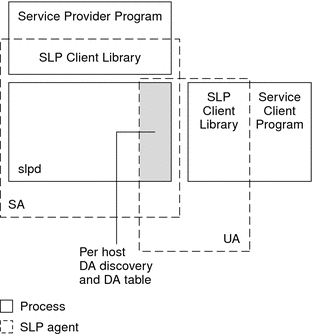SLP Implementation
In the Solaris SLP implementation, the SLP SAs, UAs, DAs, SA servers, scopes, and other architectural components in Table 7–1 are partially mapped into slpd and partially into application processes. The SLP daemon, slpd, organizes certain off-host SLP interactions to do the following:
-
Employ passive and active directory agent discovery in order to discover all DAs on the network
-
Maintain an updated table of DAs for the use of the UAs and SAs on the local host
-
Act as a proxy SA server for legacy service advertisements (proxy registration)
You can set the net.slpisDA property to also configure slpd to act as a DA. See Chapter 9, Administering SLP (Tasks).
For more information about the SLP daemon, see slpd(1M).
In addition to slpd, the C/C++ and Java client libraries (libslp.so and slp.jar) enable access to the SLP framework for UA and SA clients. The client libraries provide the following features:
-
Software that offers network services which can register and deregister service advertisements
-
Client software that can request services by issuing queries for service advertisements
-
The list of SLP scopes available for registration and requests
No special configuration is necessary to enable the inter-process communication between slpd and the client libraries that provide the previous services. You must, however, run the slpd process first before you load the client libraries in order for the libraries to function.
In the following figure, the SLP client library in the Service Provider Program employs SA functionality. The Service Provider Program uses the SLP client library to register and deregister services with slpd. The SLP client library in the Service Client Program employs UA functionality. The Service Client Program uses the SLP client library to make requests. The SLP client library either multicasts requests to SAs or unicasts them to DAs. This communication is transparent to the application except that the unicast method of issuing requests is faster. The behavior of the client library can be affected by setting various SLP configuration properties. For further information, see Chapter 9, Administering SLP (Tasks). The slpd process handles all SA functionality, such as answering multicast requests and registering with DAs.
Figure 7–3 SLP Implementation

Other SLP Information Sources
Refer to the following documents for further information on SLP:
-
Kempf, James, and Pete St. Pierre. Service Location Protocol for Enterprise Networks. John Wiley & Sons, Inc. ISBN Number: 0–471–31587–7.
-
Authentication Management Infrastructure Administration Guide. Part Number: 805–1139–03.
-
Guttman, Erik, Charles Perkins, John Veizades, and Michael Day. Service Location Protocol, Version 2, RFC 2608 from the Internet Engineering Task Force (IETF). [http://www.ietf.org/rfc/rfc2608.txt]
-
Kempf, James, and Erik Guttman. An API for Service Location, RFC 2614 from the Internet Engineering Task Force (IETF). [http://www.ietf.org/rfc/rfc2614.txt]
- © 2010, Oracle Corporation and/or its affiliates
